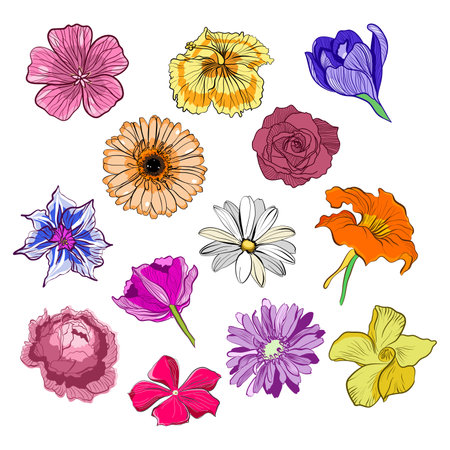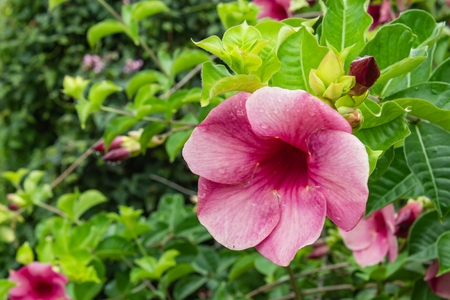Introduction to Natural Flower Colors in Indian Context
India, a land of vibrant traditions and deep-rooted spirituality, has always embraced nature as an integral part of daily life. For centuries, natural colors derived from flowers have played a significant role in Indian culture—not only for their aesthetic appeal but also for their symbolic meanings and eco-friendly qualities. Among the multitude of flowers cherished in India, Hibiscus and Jasmine hold special places due to their cultural, religious, and medicinal importance. The use of these blooms as sources of natural color is woven into the fabric of Indian rituals, festivals, textile dyeing, food preparation, and even beauty practices. In modern times, with growing awareness about sustainability and environmental impact, the relevance of Hibiscus and Jasmine as natural coloring agents is more pronounced than ever. Their gentle hues are celebrated not just for their visual beauty but also for their connection to traditional wisdom, Ayurveda, and the ethos of living in harmony with nature.
2. Traditional Uses of Hibiscus and Jasmine as Natural Colors
In India, the use of hibiscus (Gudhal) and jasmine (Mogra or Malli) flowers goes far beyond their captivating fragrance and visual appeal. These blooms have been integral to traditional Indian practices, especially for their natural coloring properties used in ceremonies, rituals, and art forms. Their roles are deeply rooted in the diverse cultures across the country, each region adapting unique methods and names for these flowers.
Significance in Ceremonies and Rituals
Hibiscus and jasmine hold sacred importance in Hindu pujas (prayer rituals), weddings, and festive celebrations. The vivid red hue of hibiscus petals is commonly offered to Goddess Kali and Lord Ganesha, symbolizing purity and divine energy. Jasmine garlands are presented to deities like Lord Vishnu and Lord Krishna, representing devotion and spiritual love. Both flowers are also essential during Pongal, Navratri, and Onam festivals.
Unique Indian Practices with Hibiscus & Jasmine Colors
| Flower | Regional Name | Traditional Use | Color Application |
|---|---|---|---|
| Hibiscus | Gudhal (Hindi), Chembarathi (Malayalam), Japakusum (Bengali) | Puja offerings, temple decorations, bridal adornment | Red dye for Kumkum, Rangoli powders, textile coloring |
| Jasmine | Malli (Tamil), Mogra (Marathi/Hindi), Mallige (Kannada) | Garlands for rituals, hair ornaments, marriage ceremonies | White pigment for traditional art, perfumed water for holy baths |
Artistic Expressions: Rangoli & Folk Art
The natural colors derived from hibiscus and jasmine are frequently seen in vibrant rangolis—decorative patterns drawn at entrances using colored powders during festivals. In South India, freshly plucked hibiscus petals are crushed to create a rich red tint for kolams and alpana designs. Jasmine’s white petals are blended into natural pastes for painting intricate motifs on walls or pots.
This deep cultural integration highlights how hibiscus and jasmine serve not only as symbols of beauty but also as natural sources of color, sustaining age-old Indian traditions while promoting eco-friendly practices.

3. Preparation Methods for Natural Colors from Flowers
In India, the traditional methods of preparing natural colors from Hibiscus and Jasmine flowers are rooted in indigenous knowledge and sustainable practices. The process begins with carefully hand-picking fresh blossoms early in the morning, when their color pigments are at their peak. For Hibiscus, the vibrant red petals are separated and gently washed to remove dust and insects, ensuring purity. These petals are then sun-dried on clean cotton cloths, a method favoured in many rural communities to conserve energy and preserve the natural essence of the flower. Once dried, the petals are crushed into a fine powder or boiled in water to extract a deep red liquid dye. This dye is commonly used for making eco-friendly Holi colors or as a natural tint in traditional crafts.
Jasmine flowers require a slightly different approach due to their delicate white petals and subtle fragrance. The petals are collected and either infused in warm water or ground with a mortar and pestle to release their gentle hues. Some families add a few drops of lemon juice or alum during extraction—a practice passed down through generations—to help fix the color and enhance its brightness. The resulting infusion produces soft pastel shades, perfect for body art, textile coloring, or even as natural face packs.
Sustainability is central to these techniques. Many Indian households reuse water from floral extractions to irrigate home gardens, while leftover flower pulp is composted, returning nutrients to the soil. By embracing these age-old methods, communities not only honor their cultural heritage but also contribute to environmental conservation—minimizing chemical waste and supporting biodiversity in their surroundings.
4. Health and Environmental Benefits
In India, the use of hibiscus and jasmine flowers as natural colors is deeply rooted in traditional wellness practices and ecological consciousness. These flowers are not only cherished for their vibrant hues but also for their multifaceted advantages that support personal health and environmental sustainability. The wisdom of Ayurveda, India’s ancient science of life, has long recognised the healing properties of both hibiscus and jasmine, making them ideal choices for those seeking holistic well-being through natural means.
Ayurvedic Perspective on Flower-Based Colors
According to Ayurveda, colors derived from nature carry unique vibrations and medicinal qualities. Hibiscus is known to balance Pitta dosha due to its cooling effect, while jasmine calms the mind and soothes stress, supporting Kapha balance. Using these flower-based colors in daily life—whether in skin care, hair applications, or festive decorations—allows individuals to benefit from their therapeutic effects without exposure to synthetic chemicals.
Comparison: Natural vs Synthetic Colors
| Aspect | Flower-Based Colors (Hibiscus & Jasmine) | Synthetic Colors |
|---|---|---|
| Health Impact | No harmful chemicals, gentle on skin and hair, often rich in antioxidants | Can cause allergies, skin irritation, or long-term health risks |
| Environmental Footprint | Biodegradable, supports soil fertility post-use, low water pollution | Non-biodegradable residues, water and soil contamination |
| Cultural Relevance | Aligned with Indian traditions, eco-friendly festivals like Holi & weddings | Lacks cultural depth, often discouraged in community rituals |
| Sustainability | Supports local farmers and circular economy in rural India | Dependent on industrial manufacturing processes |
Eco-Friendly Living and Community Well-being
The adoption of flower-based natural colors fosters a lifestyle aligned with India’s ethos of Vasudhaiva Kutumbakam—the world is one family. By choosing hibiscus and jasmine for coloring purposes, communities reduce their ecological footprint and promote harmony with nature. This practice also empowers rural women and small-scale farmers engaged in organic floriculture. Ultimately, incorporating these flowers as natural colorants nurtures both personal wellness and planetary health in a way that honors Indian tradition and supports a greener future.
5. Applications in Daily Indian Life
In India, the use of natural colors derived from Hibiscus and Jasmine flowers has deep roots in everyday life, blending tradition with sustainability. These floral dyes are cherished not just for their vibrant hues but also for their cultural resonance and eco-friendly appeal. One of the most prominent applications is in creating rangoli, the decorative floor art made during festivals like Diwali and Pongal. Here, powdered forms of Hibiscus and Jasmine provide naturally radiant reds, pinks, and off-whites, enhancing the spiritual ambiance of homes.
Textile dyeing is another significant domain where these flowers shine. Artisans across India—especially in states like Tamil Nadu, West Bengal, and Rajasthan—use Hibiscus petals to impart rich crimson shades to cotton and silk fabrics, while Jasmine offers subtle creamy tones. Sarees, dupattas, and even dhotis colored with these natural extracts hold a special place for weddings and pujas due to their auspiciousness and gentle touch on the skin.
During festive seasons, Indian households employ Hibiscus and Jasmine blooms not only as natural dyes but also as direct decorative elements. Garlands strung from fresh Jasmine are ubiquitous at weddings and temple events, while Hibiscus petals adorn deity idols in home shrines. Their application extends to coloring diyas (oil lamps), craft items, and even handmade greeting cards exchanged during Raksha Bandhan or Holi.
Furthermore, conscious urban families are now returning to these traditional practices to minimize chemical exposure. Parents often encourage children to use flower-based colors in school projects or eco-friendly Holi celebrations. The revival of such age-old customs reflects a growing awareness about sustainable living while keeping Indian heritage alive.
6. Reviving Traditional Color-Making Practices
Across India, there is a growing movement to revive and preserve the age-old traditions of making natural colors from flowers like hibiscus and jasmine. Many local communities in both rural villages and urban neighborhoods are coming together to promote the use of these eco-friendly colors, which not only hold cultural significance but also support sustainable livelihoods.
Community-Led Initiatives
In states such as Tamil Nadu, Kerala, and West Bengal, women’s self-help groups and artisan collectives have taken the lead in collecting fresh hibiscus and jasmine blooms to create vibrant natural dyes and powders. These grassroots initiatives often collaborate with local schools, temples, and panchayats to organize workshops where younger generations can learn traditional methods of extracting color from flowers using age-old techniques passed down through families.
Urban Eco-Conscious Movements
In metropolitan cities like Mumbai, Bengaluru, and Delhi, eco-conscious citizens and NGOs are championing the use of flower-based natural colors for festivals such as Holi, Ganesh Chaturthi, and Diwali. These organizations conduct awareness campaigns and host interactive sessions to educate people about the harmful effects of chemical colors on health and the environment. By encouraging residents to switch to homemade hibiscus and jasmine colors, they foster a sense of pride in Indian heritage while promoting green living.
Cultural Festivals & Sustainable Livelihoods
Several regions have also revived traditional fairs and melas where artisans display their handmade natural color products derived from locally grown flowers. These events not only celebrate India’s rich botanical diversity but also provide additional income opportunities for farmers and small entrepreneurs who cultivate hibiscus and jasmine specifically for color-making purposes. Such efforts have led to a renewed appreciation for our indigenous knowledge systems while supporting rural economies.
The revival of natural color-making practices underscores a collective commitment among Indians—from small hamlets to bustling cities—to embrace sustainability rooted in tradition. Through these community-driven efforts, the legacy of using hibiscus and jasmine as natural colors continues to thrive, inspiring future generations to value both environmental harmony and cultural heritage.

